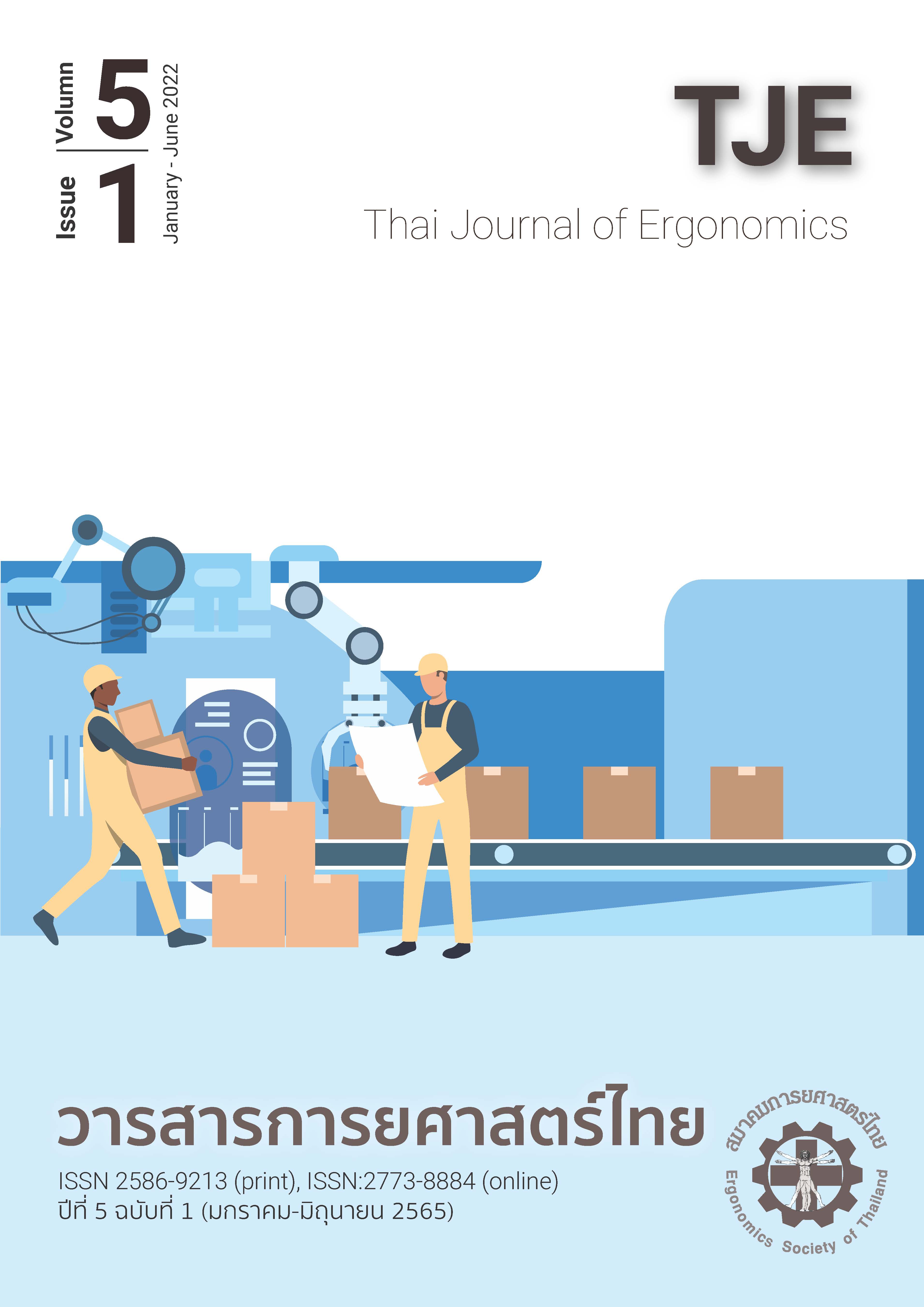Workstation improvement for reducing ergonomic risks of microscope users
Main Article Content
Abstract
Using a microscope often requires the user to work in repetitive postures for long periods of time, which can lead to fatigue and muscle dysfunction. The objectives of this research were 1) to assess the degree of fatigue of microscope users, 2) to assess the level of ergonomics risk in microscope users, and 3) to improve workstation to be suitable for ergonomic principles. The sample group in this study was twenty-two microscopes users at Suranaree University of Technology. The Body Discomfort assessment was used for evaluation of fatigue of users. Ergonomics risks of users was assessed by using Rapid Upper Limb Assessment (RULA) technique. The results of the user's fatigue level found that the most fatigued positions were neck, shoulders, upper back, upper arms, elbows, hands and wrists. The RULA risk assessment found that the Final Score was in Level 3 (additional studies and continuous monitoring may be needed, new work design may be needed) The researcher has therefore renovated the work station by designing and replacing the chair to be appropriate with anthropometric data nature of work by providing a backrest that supports the lumbar spine, an adjustable chair height and softer seat cushion. The improvement results showed that the risk level with RULA was reduced to level 2 (acceptable, but there may be an ergonomic problem if the work was performed repeatedly for a longer period of time). decreased feeling of fatigue. As a result, most users are satisfied with the improvement of the microscope workstation at a high level.
Article Details

This work is licensed under a Creative Commons Attribution-NonCommercial-NoDerivatives 4.0 International License.
References
Sillanplili J, Nyberg M, Laippala P. A new table for work with a microscope - A Solution to ergonomic problems. Appl Ergon. 2003;34(6):621-6.
Nupura RN, James G. Prevalence of musculoskeletal problems and awareness about ergonomics in laboratory technicians working on microscope. Int J Physiother Res 2017;5(3):2073-6.
George E. Occupational hazard for pathologists: microscope use and musculoskeletal disorders. Am J Clin Pathol. 2010;133:543–8.
Franco G. Health disorders and ergonomic concerns from the use of the microscope: A voice from the past. Am J Clin Pathol. 2011;135:170–1.
Agrawal PR, Maiya AG, Kamath V, Kamath A. Musculoskeletal disorders among medical laboratory professionals-a prevalence study. Int J Res Med Sci. 2014;2(4):1262-6.
George E. Occupational hazard for pathologists: Microscope use and musculoskeletal disorders. Am J Clin Pathol. 2010;133(4):543-8.
Thompson SK, Mason E, Dukes S. Ergonomics and cytotechnologists: Reported musculoskeletal discomfort. Diagn Cytopathol. 2003;29(6):364-7.
LaDou J, Harrison R, editors. Current occupational & environmental medicine. New York: McGraw-Hill; 2014.
Corlett EN, Bishop RP. A technique for measuring postural discomfort. Ergonomics. 1976; 9:175-82.
McAtamney L, Corlett EN. RULA: A survey method for the investigation of work-related upper limp disorder. Appl Ergon. 1993;24(3):91-9.
Anish AG, Shubhangi AM, Malik AA, Monal BY, Shweta P, Nilesh P. Ergonomic microscope: need of the hour. J Clin Diagnostic. 2015;9(5):62-5.
Kim M-S. Influence of neck pain on cervical movement in the sagittal plane during smartphone use. J Phys Ther Sci. 2015;27:15–7.
Yassierli Y, Juraida A. Effects of netbook and tablet usage postures on the development of fatigue, discomfort and pain. J Eng Technol Sci. 2016;48:243–53.
Leivseth G, Drerup B. Spinal shrinkage during work in sitting posture compared to work in a standing posture. Clin Biomech. (Bristol, Avon) 1997;12:409-18.
Darragh AR, Harrison H, Kenny S. Effect of an ergonomics intervention on workstations of microscope workers. Am J Occup Ther. 2008;62:61-9.


